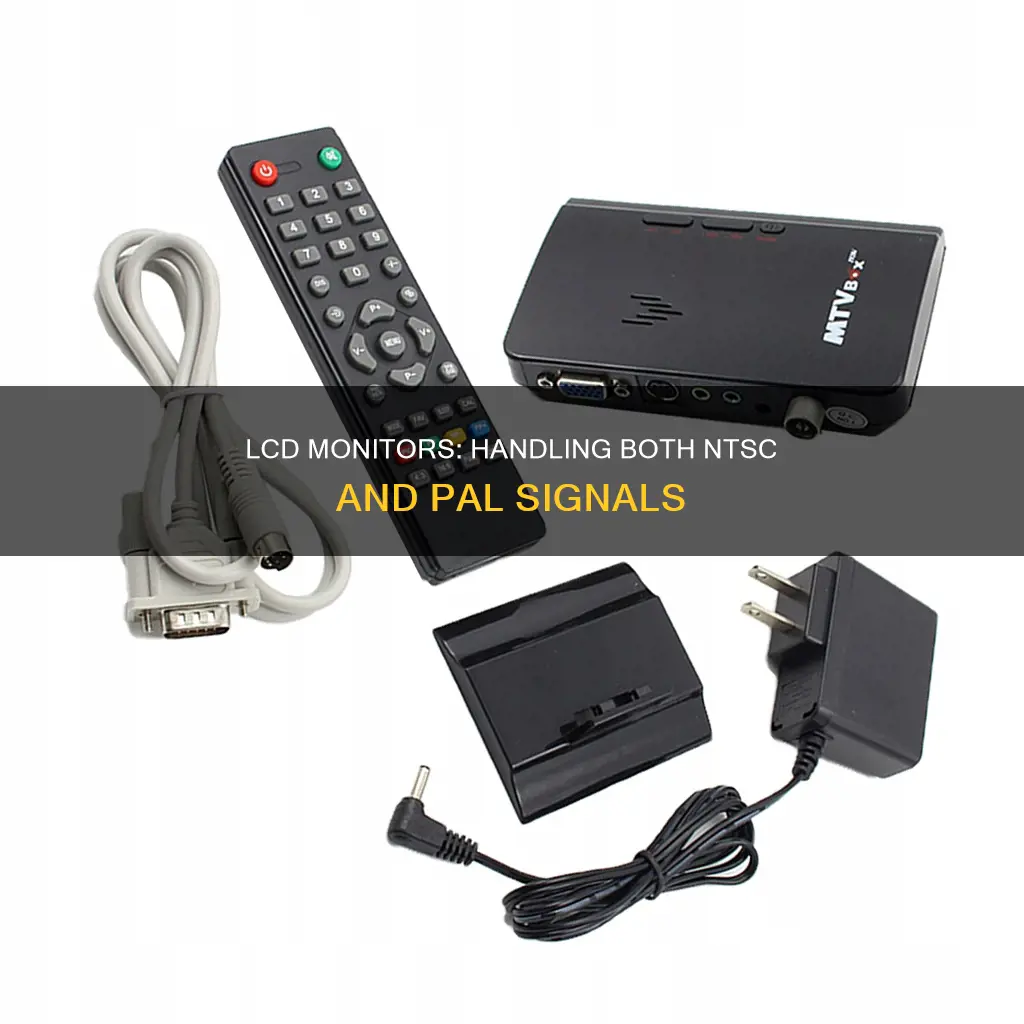
The NTSC and PAL are analog video standards that are still relevant despite the shift to digital TV and HDTV. The two standards differ in their frame rates, with NTSC displaying 30 frames per second and PAL displaying 25 frames per second. This difference in frame rates persists even with digital and HDTV, reinforcing the barrier to a universal video standard. As a result, the question arises: do LCD monitors support both NTSC and PAL formats?
| Characteristics | Values |
|---|---|
| LCD monitors that support both NTSC and PAL | Depends on the tuner; some LCD TVs do not support NTSC |
| NTSC tuner location | NTSC countries: US, Canada, Mexico, parts of Central and South America, Japan, Taiwan, and Korea |
| PAL tuner location | PAL countries: UK, Germany, Spain, Portugal, Italy, China, India, Australia, most of Africa, and the Middle East |
| NTSC format | 525-line or pixel row, 60 fields with 30 frames-per-second, at 60 Hz |
| PAL format | 625 line or pixel row, 50 fields with 25 frames a second, 50Hz |
| Connection standard | HDMI |
What You'll Learn
- NTSC and PAL are broadcast standards
- HDMI is a connection standard
- NTSC is the official analogue video standard in the US, Canada, Mexico, parts of Central and South America, Japan, Taiwan and Korea
- PAL is the dominant analogue format in the world for TV broadcasting and analogue video display
- DVDs are still made in either the NTSC or PAL format

NTSC and PAL are broadcast standards
NTSC (National Television System Committee) and PAL (Phase Alternating Line) are indeed broadcast standards. They are two of the three main analog video broadcast standards used around the world, the third being SECAM (Sequential Couleur Avec Memoire or Sequential Color with Memory).
NTSC was the first American standard for analog television, published and adopted in 1941. It was initially created for black-and-white television, but a second NTSC standard was adopted in 1953 to allow for colour television broadcast. In NTSC, 30 frames are transmitted each second, with each frame made up of 525 individual scan lines.
PAL was first developed in Western Europe around 1950. It is the predominant video standard used overseas and has been adopted by a few 60Hz countries, including Brazil. In PAL, 25 frames are transmitted each second, and each frame consists of 625 individual scan lines.
The differences between the two standards are due in part to the different electrical power systems in use. In the US and other countries, electrical power is generated at 60Hz, so the NTSC signal is also sent out at 60 fields per second. In contrast, Europe uses a 50Hz power supply, so the equivalent PAL lines go out at 50 fields per second, or 25 alternating lines.
The use of different broadcast standards means that a video from a PAL country will not play in a country that uses the NTSC standard, and vice versa. However, most region-free DVD players can convert between PAL and NTSC and will send the appropriate signal to the TV regardless of the video format on the disc.
Asus Monitor: Website Ordering Worth It?
You may want to see also

HDMI is a connection standard
HDMI stands for High-Definition Multimedia Interface. It is a standard that supports high-definition digital video and multi-channel digital audio on a single cable. The HDMI cable connection transmits both video and audio data in a digital format. HDMI connections stand in contrast to analog VGA or DVI connections, which transmit only video data.
HDMI has since become the most popular way to transmit uncompressed audio and video, with almost all televisions and computer monitors supporting the interface. As of January 2021, nearly 10 billion HDMI devices have been sold.
HDMI implements the ANSI/CTA-861 standard, which defines video formats and waveforms, transport of compressed and uncompressed LPCM audio, auxiliary data, and implementations of the VESA EDID. It is backward compatible with single-link Digital Visual Interface digital video (DVI-D or DVI-I, but not DVI-A or dual-link DVI). No signal conversion is necessary when using a DVI-to-HDMI adapter, nor is there a loss of video quality.
There are several versions of HDMI, each introducing new features and capabilities. These include:
- HDMI 1.0: Released in 2002, this was the first version of HDMI, designed to be backward-compatible with DVI-HDTV. It allowed for a maximum TMDS clock of 165 MHz and defined two connector types, called Type A and Type B.
- HDMI 1.1: Released in 2004, this version added support for DVD-Audio.
- HDMI 1.2: Released in 2005, this version added support for One Bit Audio (used on Super Audio CDs) and removed the requirement that only explicitly supported formats be used.
- HDMI 1.3: Released in 2006, this version increased the maximum TMDS clock to 340 MHz and added support for deep color (10 bpc, 12 bpc, and 16 bpc color depth). It also introduced the HDMI Type C "Mini" connector for portable devices.
- HDMI 1.4: Released in 2009, this version defined standardized timings for 4K resolutions and introduced an HDMI Ethernet Channel (HEC), an audio return channel (ARC), and a new Micro HDMI Connector.
- HDMI 2.0: Released in 2013, this version increased the maximum bandwidth to 18.0 Gbit/s, enabling support for 4K video at 60 Hz with 24-bit color depth. It also introduced support for the Rec. 2020 color space, up to 32 audio channels, and enhanced audio return channel (eARC).
- HDMI 2.1: Released in 2017, this version further increased the maximum bandwidth to 48 Gbit/s, enabling support for 4K at 120 Hz and 8K at 60 Hz. It also introduced a new "Ultra High Speed" HDMI cable category to support these higher speeds.
HDMI connectors are available in three sizes: standard (Type A), mini (Type C), and micro (Type D). The standard HDMI connector (Type A) is the most widely used and can be found on almost every brand of TV, computer monitor, game console, streaming device, and desktop computer. Mini HDMI connectors (Type C) are typically used on portable devices such as DSLR cameras and tablets, while micro HDMI connectors (Type D) are used on small, portable devices such as phones.
Monitoring FPS, CPU, GPU, and RAM: A Comprehensive Guide
You may want to see also

NTSC is the official analogue video standard in the US, Canada, Mexico, parts of Central and South America, Japan, Taiwan and Korea
NTSC, which stands for National Television System Committee, is the official analogue video standard in the US, Canada, Mexico, parts of Central and South America, Japan, Taiwan, and South Korea. It was the first American standard for analogue television and was published and adopted in 1941.
NTSC is one of three major colour formats for analogue television, the others being PAL and SECAM. It is also known as System M, which was assigned to it in 1961. The NTSC/System M standard was used in most of the Americas (except Argentina, Brazil, Paraguay, and Uruguay), Myanmar, South Korea, Taiwan, the Philippines, Japan, and some Pacific Island nations and territories.
The NTSC standard has 525 total lines, 480 of which are visible, and these 480 lines are what give reference to the 480i resolution commonly found in analogue televisions.
NTSC was replaced by digital broadcasts in 44 of Japan's 47 prefectures on 24 July 2011. Analogue broadcasting ended in the remaining three prefectures—Iwate, Miyagi, and Fukushima—on 31 March 2012, after being delayed by the 2011 Tōhoku earthquake and tsunami.
In terms of LCD monitors, it depends on whether the tuner supports PAL and/or NTSC. There are LCD TVs that do not support NTSC. However, most decent region-free DVD players can convert between PAL and NTSC and will send the appropriate signal to the TV.
Monitoring Employee Web Usage: Strategies for Effective Surveillance
You may want to see also

PAL is the dominant analogue format in the world for TV broadcasting and analogue video display
PAL, or Phase Alternating Line, is the most widely adopted analogue format for TV broadcasting and analogue video display. It is used in many more countries than NTSC, including the UK, Germany, Spain, Portugal, Italy, China, India, Australia, most of Africa, and the Middle East.
PAL was developed in the 1960s by Walter Bruch at Telefunken AG in Germany, with the goal of providing a colour TV standard for Europe. It has a refresh rate of 25 times per second, creating a smooth transition from frame to frame. The picture is made up of 625 interlaced lines, with 576 lines carrying a visible image. This method increases the vertical resolution within the PAL format and reduces flicker in the video while maintaining fluid motion.
PAL is a colour encoding system for analogue television, and one of three major analogue colour television standards, the others being NTSC and SECAM. It is broadcast at 625 lines and 50 fields (25 frames) per second and is associated with CCIR analogue broadcast television systems.
PAL is an analogue system, so it is not utilised by streaming services such as Netflix. However, it is still used with broadcast television and physical media such as DVDs, Blu-ray, and 4K Blu-ray players.
While LCD TVs and monitors may require a tuner that is compatible with the signal being received, such as PAL or NTSC, this is not an issue when using connections such as HDMI, as these are independent of the NTSC/PAL issue.
HD Monitor Sizes: Understanding the Options for Your Setup
You may want to see also

DVDs are still made in either the NTSC or PAL format
DVDs are still labelled as either NTSC or PAL format. This is because, despite modern TVs and monitors not strictly using the NTSC format, the timings, resolutions, and refresh rates established in these systems are still used in modern televisions and monitors.
NTSC format is the colour encoding system used by DVD players and, until recently, broadcast television in North America, Japan, and most of South America. PAL format is the colour encoding system used by DVD players and broadcast television in Europe, most of Asia and Oceania, most of Africa, and parts of South America.
NTSC is the National Television System Committee standard, named after the committee that developed and enforced it in 1953. It was very popular until it was superseded by modern digital television systems.
PAL formatting, along with a third common standard called SECAM, was developed in the late 1950s to deal with certain shortcomings of the NTSC system. The way NTSC encodes colour meant the signal lost clarity under poor conditions, so early NTSC systems were vulnerable to bad weather, large buildings, rough terrain, and other factors. To solve this problem, the PAL format reverses every second line in the signal, effectively cancelling out errors.
DVDs are still made in either NTSC or PAL format primarily for content regionalisation. Using different video formats acts as a layer of physical protection to reinforce national copyright laws and prevent movies and television from being distributed in countries without permission.
NTSC is used in the United States, Canada, Japan, South Korea, Mexico, Central America, parts of South America and some other countries. PAL is used in Great Britain, most countries in Europe and Africa, Australia, the Middle East, China, India and some other countries.
Most DVD players from PAL/SECAM areas can play both PAL and NTSC DVDs, but most NTSC players will not play a PAL disc. Most computers and DVD software can play both NTSC and PAL DVDs/videos.
Monitoring Data Usage: TDS Telecommunications Service Guide
You may want to see also
Frequently asked questions
It depends on whether the tuner supports both formats. LCD TVs that only support one format do exist.
NTSC and PAL are broadcast standards. NTSC is the official analog video standard in the US, Canada, Mexico, some parts of Central and South America, Japan, Taiwan, and Korea. PAL is the dominant format in the world for analog TV broadcasting and is used in Europe, most of Asia and Oceania, most of Africa, and parts of South America.
Check the manual or settings of your LCD monitor. Many modern HD and 4K TVs can switch between PAL and NTSC.
You would need a converter in between the wall and your TV.







